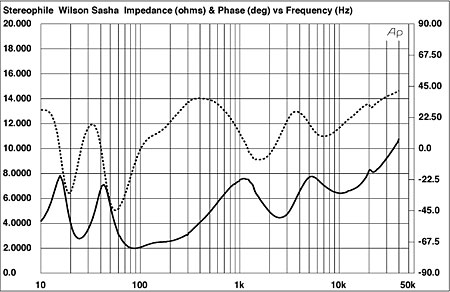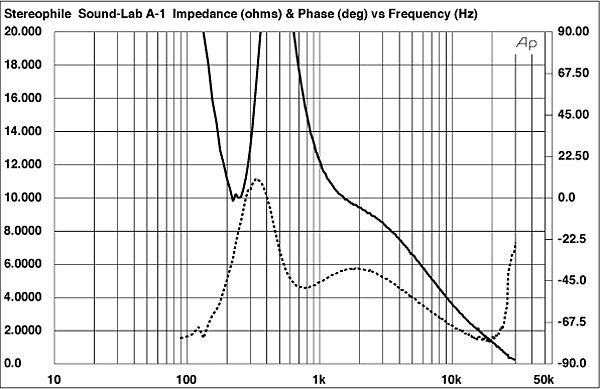@bugredmachine ,
You made the comment no one is buying Fidelium because of the resistance. No, because until I raised the issue, I no one seemed to know. I took a look at your system. Nice speakers and electronics. You mentioned you had 11 foot, but likely meant 10. That is 1.8 ohms total resistance.
At 100 ohms, your speaker is near 2 ohms impedance and if I am reading this graph correctly, near 0 degrees phase. Your amplifiers potential power output at that frequency is reduce to only 27.8% of its potential value with a low resistance cable. The decrease in amplitude at 100Hz compared to 1.2KHz is 3.7db. This is all caused by the resistance of the cable.
I know tube amplifiers often have high output impedance so it is not shocking to me that this cable could be reviewed positively. Could this cable cause a solid state amplifier to have a tube like sound? Maybe this is another of the secret sauce for many to prefer tube amplifiers and many to not like them.

|
I made my moniker deludedaudiophile, but it appears I should have saved that for you @steakster and a few others. I continue to be surprised at how bizarre it is here.
Do you have any comment on what I have discovered about the high resistance of the Fidelium cable after I checked it out of interest or are you just a troll? I expect the latter.
|
My cables are equivalent to about 11 awg. That mean's their resistance (about 8 ft) is 0.02 ohms in total based on an online calculator.
I assure you bugredmachine, there is no magic in flat or round, the same electromagnetic equations still apply. Some manufacturers of audio products would like you to believe that is not true. If they proved anything, they would publish in a respected journal.
|
I didn’t see anyone complaining about price. I saw you putting down people though. Your lack of understanding is not a fault in other people.
|
If you mean me, then no, I am quite sure that I read it quite correct. However, it contradicts itself which is not my fault.
|
This is text from what I believe are one of of Silversmith’s patents and while it is not specific to the ribbon, it relates to the thought process. @dgluke , I am not sure if your comment was directed at me, but I think I read the marketing sheet accurately and interpreted it accurately. This would imply the Fidelium could be high in resistance. This would contribute heavily to a distinctive sound signature.
https://pubchem.ncbi.nlm.nih.gov/patent/US-2020303092-A1
A method for reducing frequency dependent energy loss and phase errors from end to end as a function of the frequency of audio-range signals conducted therein including obtaining an electrical wire having a first end and an opposing second end and comprising of an electrically conductive metal with a conductivity between 0 and about 3.2* 106 (ohm-meter)−1 or between 0 and about 5.5% International Annealed Copper Standard (IACS), wherein the electrically conductive metal includes a relative magnetic permeability between 0 and 2, and transmitting audio-range signals from the first end to the second end, wherein the frequency dependent energy loss and phase from the first end to the second end is a function of a frequency of the audio-range signals transmitted therein.
|
@cd45123
I popped over to their website out of curiosity. I don't there there is any way to determine the inductance as it would be conditional on how close or how far you kept the two conductors from each other. There width would negate some of the variability, but there will still be variability.
There is some contradiction in the statement below. I don't believe they have a metal alloy 33 times better than copper or silver (one does not exist), however, the claim below it compares it to a thickness of 5.5 times less. I don't see any particular benefit to a 0.00018 equivalent thickness of copper of silver. That is sufficient for about 200MHz back of envelope. It does sound impressive though. Any metal alloy with a skin depth of 5.5x that of copper or silver will unfortunately be a higher resistance alloy comparatively.
Since they are unlikely to have the resources to create their own alloy, I have to assume they are using something off the shelf. Monel and Constantan alloys are both up in the 5.5x range almost exactly and are Nickel/Copper alloys. However, they are really awful conductors. A pair of speaker cables could have resistance as much as 1 ohm. That would explain a unique sound.
FYI - materials science guy, semiconductors and batteries so this stuff is old hat for me.
The skin-effect characteristics of our state-of-the-art FIDELIUM alloy are up to 33 times superior to those of copper or silver. The FIDELIUM speaker cable, already at less than a thousandth of an inch thick, performs as if it were 5.5 times thinner, thus experiencing less frequency dependent attenuation and phase distortion than even a .00018 inch thick copper or silver ribbon or 64 gauge wire.
|
What you are hearing when you use the Fidelium cable will not be the the lack of connectors, or the wire, or the insulators it will be the very high resistance of the cable compared to other cables. Are there any other speaker cables on the market that have as high of resistance as these cables? I wonder if the people advocating for this cable understand how much resistance it is adding to the total connection. Do you have an amplifier with high damping factor? You do not any more.
|
Now that I understand the cables I would not put them in my system. My speakers impedance drops below 3 ohms. If i use these it would cause changes in the frequency response significant enough to be heard. Rough estumate is as much as a 3db change in the response at some frequencies. That is huge and I didn't pay money for a good speaker to screw it up I am not surprised people experience a difference compared to other cables I don't know how you would not.
My amp has high damping factor. This cable would also destroy that property. It would also cause a loss of 2.5db of headroom. I would lose 100 watts from my amp.
|
Do people advocating this cable realize it will add a large resistance between their speaker and amplifier? This will change the frequency response of your system. The change will be large enough to be audible. I am not sure people realize this and it is not clear on the website. You could be adding almost 2 ohms to your speaker connection. That is big.
|
Some seriously troubled people here.
|
mrmb,
The only impedance curve I could observe for Soundlab was the A1 on Stereophile. I will attempt to insert it here. If this speaker was used with these Fidelium cables there must a change, I would consider large, in the frequency response, more so with the 10 foot version. That change, based on the graph below which may not be appropriate, would mainly be a gradual reduction in high frequencies starting at approximately 2KHz, increasing to a 3db drop by 10KHz, and 6db at 20Khz. My ears have not heard 20KHz in many decades, but I would notice a change at 10KHz of several db (at least I think I would). There could be a small emphasis close to 200Hz that is audible.
Perhaps what this cable does is lay bare the audiophile claim that they "really know there systems and would know if something changed". I don't mean that specifically to you mrmb. Unless a speaker has constant impedance, this cable must make significant frequency response changes. I don't think that can be debated, though the amount of change will depend on speaker impedance. Some users really enjoy this cable, but I have not read any comments (other than negative) that indicate a realization of significant changes in frequency response.

|
Race card? You made an offensive racist insensitive trope. You really need to look in the mirror and try to be a better person. That wasn't acceptable in 1972 let alone 2022.
|
@noske I calculated as much as 1.45 mm^2. Looking at an online chart, that is between 15 and 16 awg. The resistance comes from the materials used in construction, not the very thin nature of it.
|
It is not copper. I have surmised, based on the marketing information, I believe with some accuracy that is is a nickel copper alloy. There are not many readily available alloys that meet all the criteria. I has been verified that my estimates of resistance are accurate.
I would have assumed that would have opened up some interesting discussions about the properties and what it would do, but I forget the natural reaction is for people to stick their head in the sand.
|
@noske That is what I normally see is lots of impressive sounding words, but they never talk about audio. A cable with 94% of the speed of light? That sounds very impressive. How does that matter for what gets to my speakers? I think that is a case of extrapolating well beyond a domain of validity.
|
Oh great, the strange obsessed conspiracy theory guy is back. Happy Friday everyone. Would it make you happier if I asked the engineers at work if they have something close to a 1.8 ohm resistor of suitable size that I could add to my speaker cables? I doubt it would, though it would sound exactly like this cable.
|
Your obsession is really bizarre.
1+1 = 2, whether I went to Harvard or a 3rd rate college, or whether I use a calculator or piece of paper.
I work with academics. They try to do this when they are losing an argument. They try to find out your academic pedigree in hopes you came from a 2nd rate or even better 3rd rate university so they can attack your background. Academics can be as immature as audiophiles or vice versa.
|
@thyname posting nonsense does not change what you wrote. Would you like me to post that in every thread you participate in? This place is unusual but weird boogyman conspiracies are a bit over the top as are racist tropes. You need to learn to be a better person.
|
That's funny @steakster , because someone private messaged me that my response to @tsushima1 should be to ask about his unhealthy obsession with some members on here, I assume are former?
Here, I thought he was just part of the harassment crew with you. Should I judge you by the company you keep?
No agenda, @tsushima1, just continually surprised by what I would consider apologetics for bad corporate behavior, sort of like I am surprised by the lack of consideration shown to you (or in general) in this picture.

|




